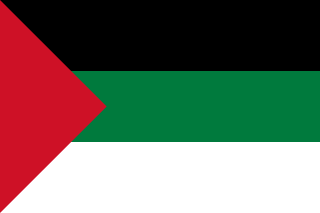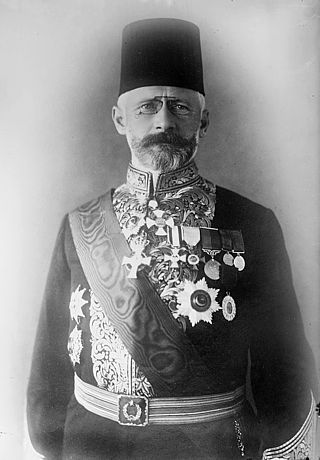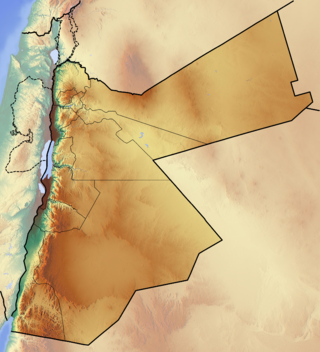
With the exception of a railway system, Jordan has a developed public and private transportation system. There are three international airports in Jordan. The Hedjaz Jordan Railway runs one passenger train a day each way.

Transport in Saudi Arabia is facilitated through a relatively young system of roads, railways and seaways. Most of the network started construction after the discovery of oil in the Eastern Province in 1952, with the notable exception of Highway 40, which was built to connect the capital Riyadh to the economically productive Eastern Province, and later to the Islamic holy city of Mecca and the port city of Jeddah. With the economic growth of the 1970s, the Kingdom of Saudi Arabia has initiated many infrastructure development projects across the country, and the extensive development of the transportation network has followed suit in support of various economic developments.

The Emirate of Transjordan, officially known as the Amirate of Trans-Jordan, was a British protectorate established on 11 April 1921, which remained as such until achieving formal independence in 1946.

The Hejaz railway was a narrow-gauge railway that ran from Damascus to Medina, through the Hejaz region of modern day Saudi Arabia, with a branch line to Haifa on the Mediterranean Sea. It was a part of the Ottoman railway network and the original goal was to extend the line from the Haydarpaşa Terminal in Kadıköy, Istanbul beyond Damascus to the Islamic holy city of Mecca. However, construction was interrupted due to the outbreak of World War I, and it reached only to Medina, 400 kilometres (250 mi) short of Mecca. The completed Damascus to Medina section was 1,300 kilometres (810 mi).

Aqaba is the only coastal city in Jordan and the largest and most populous city on the Gulf of Aqaba. Situated in southernmost Jordan, Aqaba is the administrative center of the Aqaba Governorate. The city had a population of 148,398 in 2015 and a land area of 375 square kilometres (144.8 sq mi). Today, Aqaba plays a major role in the development of the Jordanian economy, through the vibrant trade and tourism sectors. The Port of Aqaba also serves other countries in the region.

The Arab Revolt or the Great Arab Revolt was an armed uprising by the Arabs against the Ottoman Empire amidst the Middle Eastern theatre of World War I.

Ma'an is a city in southern Jordan, 218 kilometres (135 mi) southwest of the capital Amman. It serves as the capital of the Ma'an Governorate. Its population was approximately 41,055 in 2015. Civilizations with the name of Ma'an have existed at least since the Nabatean period—the modern city is just northwest of the ancient town. The city is an important transport hub situated on the ancient King's Highway and also on the modern Desert Highway.

The Hashemite Kingdom of Hejaz was a state in the Hejaz region of the Western Asia that included the western portion of the Arabian Peninsula that was ruled by the Hashemite dynasty. It was self-proclaimed as a kingdom in June 1916 during the First World War, to be independent from the Ottoman Empire, on the basis of an alliance with the British Empire to drive the Ottoman Army from the Arabian Peninsula during the Arab Revolt.
Jordan Phosphate Mines (JPMC) is a mining company based in Amman, Jordan. The company operates 3 mining facilities in Jordan and a chemical manufacturing complex in Aqaba. The company is listed on the Amman Stock Exchange's ASE Weighted Index as "JOPH".

The Jezreel Valley railway, or the Valley Train was a railroad that existed in Ottoman and British Palestine, reconstituted as a modern railway in Israel in the 21st century. It runs from the Mediterranean coast inland along the length of the Jezreel Valley. The historical line was a segment of the longer Haifa–Dera'a Line, which was itself a branch of the larger Hejaz railway.

General Establishment of Syrian Railways is the national railway operator for the state of Syria, subordinate to the Ministry of Transportation. It was established in 1956 and was headquartered in Aleppo. Syria's rail infrastructure has been severely compromised as a result of the ongoing conflict in the country.
Total: 507 km - narrow gauge of 1,050 mm (2008) Railway companies in Jordan are:

Hejaz railway station is a former main railway station in central Damascus, Syria, close to the Marjeh Square.

The Hedjaz Jordan Railway is one of the two successor railways to the famous Hedjaz Railway. When the Ottoman Empire collapsed in 1920, the Hedjaz Railway, formerly under Ottoman control, was divided into 2 railways: the Chemin de Fer de Hedjaz Syrie (CFH) and the Hedjaz Jordan Railway (HJR). The HJR operated the line of the Hedjaz railway in Jordan. When Jordan was formed in 1946, the railway served as the state railway of Jordan, though it was not owned by the state. In 1975 the HJR built a line branch line from Ma'an to Aqaba, a port city. The line was later sold to the Aqaba Railway Corporation in 1979. The Hedjaz Jordan Railway still operates today between the Jordan/Syria border, through Amman to Irbid.
The Damascus–Amman train or Damascus–Amman railway is an international train service operating on the former Hedjaz Railway from Damascus, Syria to Amman, Jordan. It is currently the only passenger train operating in Jordan. The train operates on narrow gauge tracks of 1,050 mm.

The Port of Aqaba is the only port in Jordan, and is owned by Aqaba Development Corporation (ADC) and has 12 terminals operated by five operators: the Aqaba Company for port management and operation; Aqaba Container Terminal; Industrial Port Company; phosphate Company; National Electricity power Company, and the pilotage operated by Aqaba Port Marine Services Company.

Heinrich August Meissner was a German engineer who was largely responsible for the railway network in the Ottoman Empire, and later helped manage the network in Turkey. He attained the high-ranking honorary title of pasha in the empire.

Mudawwara is the most southerly settlement in Jordan. It is administratively part of the Ma'an Governorate. The village had a population of 691 in the 2015 census.

The Occupation of Ma'an was the post-World War I occupation of the Sanjak of Ma'an, which straddled the regions of Syria and Arabia, by members of the Hashemite family, who came to power in various regions of the Near East and Arabia; they were King Hussein in the Kingdom of Hejaz, Emir Faisal representing the Arab government in Damascus and Abdullah, who was to become Emir of Transjordan. The region includes the governorates of Ma'an and Aqaba, today in Jordan, as well as the area which was to become a large part of the Israeli Southern District, including the city of Eilat.

The Jordan–Saudi Arabia border is 731 km (454 mi) in length and runs from the Gulf of Aqaba in the south-west to the tripoint with Iraq in the north-east.


















